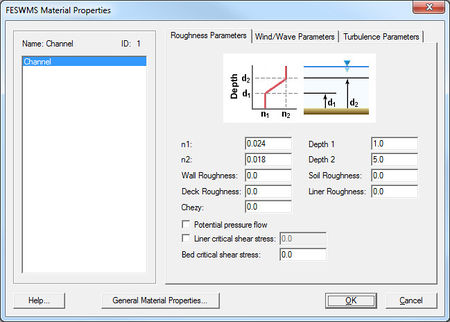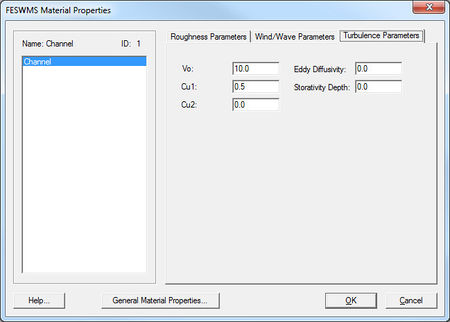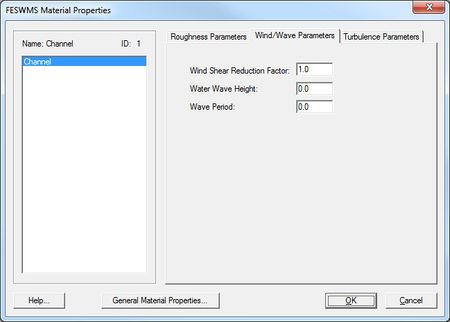SMS:FESWMS Material Properties: Difference between revisions
From XMS Wiki
Jump to navigationJump to search
| Line 5: | Line 5: | ||
The roughness helps determine the energy losses as water flows over elements. Each material includes roughness information. | The roughness helps determine the energy losses as water flows over elements. Each material includes roughness information. | ||
* Manning n values (n1, n2, depth1, depth2) | * Manning n values (n1, n2, depth1, depth2) | ||
The primary roughness property is the manning n value associated with the element. The manning n value can vary with depth by specifying n values at two depths. The n1 value is used below depth1. The n2 value is used above depth2. Between depth1 and depth2 the n value is linearly interpolated. | *:The primary roughness property is the manning n value associated with the element. The manning n value can vary with depth by specifying n values at two depths. The n1 value is used below depth1. The n2 value is used above depth2. Between depth1 and depth2 the n value is linearly interpolated. | ||
* Wall roughness | * Wall roughness | ||
The wall roughness is used on the edge of the model domain. Wall roughness is ignored unless the model is using semi-slip boundaries. | *:The wall roughness is used on the edge of the model domain. Wall roughness is ignored unless the model is using semi-slip boundaries. | ||
* Soil Liners | * Soil Liners | ||
FESWMS can be used with materials representing a soil liner. To use a liner, turn on the linear critical shear stress and set the value. When using a liner n1, n2, depth1, and depth2 are ignored. | *:FESWMS can be used with materials representing a soil liner. To use a liner, turn on the linear critical shear stress and set the value. When using a liner n1, n2, depth1, and depth2 are ignored. | ||
* Pressure flow | * Pressure flow | ||
It is required to toggle on "potential pressure flow" with all materials that are assigned to elements with a ceiling elevation. If pressure flow is enabled, the deck roughness is the manning value for the bridge deck. Otherwise deck roughness is ignored. | *:It is required to toggle on "potential pressure flow" with all materials that are assigned to elements with a ceiling elevation. If pressure flow is enabled, the deck roughness is the manning value for the bridge deck. Otherwise deck roughness is ignored. | ||
* Chezy | * Chezy | ||
Chezy values are an alternative to using Manning n values for roughness. You must turn on chezy in the model parameters to use this value. | *:Chezy values are an alternative to using Manning n values for roughness. You must turn on chezy in the model parameters to use this value. | ||
* Bed critical shear stress | * Bed critical shear stress | ||
The bed critical shear stress is used to compute clear water scour. | *:The bed critical shear stress is used to compute clear water scour. | ||
=== Turbulence Parameters === | === Turbulence Parameters === | ||
Revision as of 18:15, 24 April 2013
Material properties include roughness, turbulence, and wind/wave parameters.
Roughness Parameters
The roughness helps determine the energy losses as water flows over elements. Each material includes roughness information.
- Manning n values (n1, n2, depth1, depth2)
- The primary roughness property is the manning n value associated with the element. The manning n value can vary with depth by specifying n values at two depths. The n1 value is used below depth1. The n2 value is used above depth2. Between depth1 and depth2 the n value is linearly interpolated.
- Wall roughness
- The wall roughness is used on the edge of the model domain. Wall roughness is ignored unless the model is using semi-slip boundaries.
- Soil Liners
- FESWMS can be used with materials representing a soil liner. To use a liner, turn on the linear critical shear stress and set the value. When using a liner n1, n2, depth1, and depth2 are ignored.
- Pressure flow
- It is required to toggle on "potential pressure flow" with all materials that are assigned to elements with a ceiling elevation. If pressure flow is enabled, the deck roughness is the manning value for the bridge deck. Otherwise deck roughness is ignored.
- Chezy
- Chezy values are an alternative to using Manning n values for roughness. You must turn on chezy in the model parameters to use this value.
- Bed critical shear stress
- The bed critical shear stress is used to compute clear water scour.
Turbulence Parameters
Turbulence parameters are used to control the energy lost in turbulence.
- Vo – Base eddy viscosity in Length^2/second
- Cu1, Cu2 – Turbulence model coefficients used to modify base eddy viscosity
- Eddy diffusivity – used to modify base eddy viscosity and is related to the amount of curves in the channel
- Storativity depth – The global storativity depth (specified in the model parameters) can be overriden on a material level by entering a non-zero value.
Wind/Wave Parameters
- Wind Shear Reduction Factor
- Water Wave Height
- Wave Period
Related Topics
SMS – Surface-water Modeling System | ||
|---|---|---|
| Modules: | 1D Grid • Cartesian Grid • Curvilinear Grid • GIS • Map • Mesh • Particle • Quadtree • Raster • Scatter • UGrid |  |
| General Models: | 3D Structure • FVCOM • Generic • PTM | |
| Coastal Models: | ADCIRC • BOUSS-2D • CGWAVE • CMS-Flow • CMS-Wave • GenCade • STWAVE • WAM | |
| Riverine/Estuarine Models: | AdH • HEC-RAS • HYDRO AS-2D • RMA2 • RMA4 • SRH-2D • TUFLOW • TUFLOW FV | |
| Aquaveo • SMS Tutorials • SMS Workflows | ||


